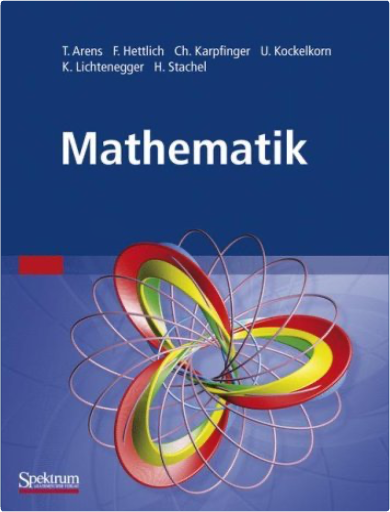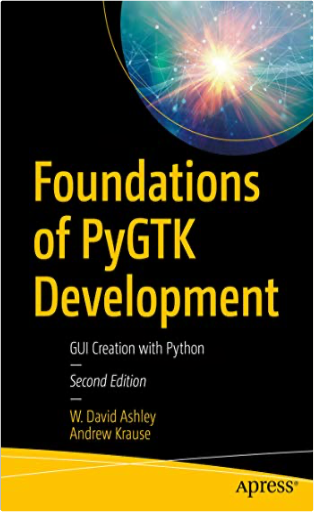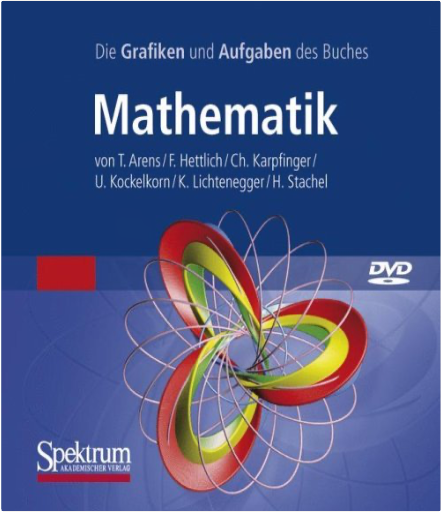 Die Grafiken und Aufgaben des Buches MathematikT. Arens, Frank Hettlich, Christian Karpfinger, Ulrich Kockelkorn, Klaus Lichtenegger, Hellmuth Stachel Die Grafiken und Aufgaben des Buches MathematikT. Arens, Frank Hettlich, Christian Karpfinger, Ulrich Kockelkorn, Klaus Lichtenegger, Hellmuth Stachel Die Bild-DVD zum Lehrbuch Mathematik ermöglicht Dozenten, die mehr als 1000 Abbildungen des Buches in der Lehre zu nutzen - sei es in Form von Folien, Ausdrucken oder über einen Beamer. Die im PDF-Format gespeicherten Abbildungen sind entsprechend ihrer Nummerierung im Buch sortiert und darüber hinaus auch über die Inhalte der Bildunterschriften recherchierbar. Zu jedem Kapitel des Buchs ist eine Power-Point-Präsentation vorbereitet, die alle Abbildungen des Kapitels enthält. Zudem enthält die DVD die Aufgaben und Lösungen sämtlicher Aufgaben des Buchs als LaTeX-Quellcode zur Übernahme in eigene Aufgabenblätter. 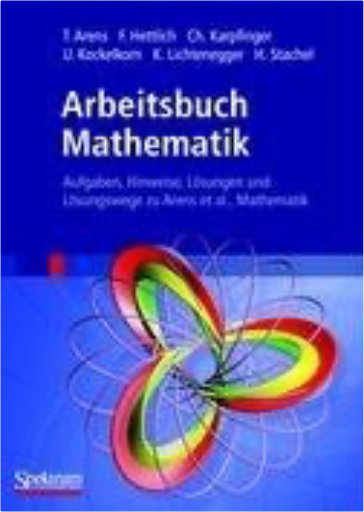 Arbeitsbuch Mathematik: Aufgaben, Hinweise, Lösungen und LösungswegeTilo Arens, Frank Hettlich, Christian Karpfinger, Ulrich Kockelkorn, Klaus Lichtenegger, Hellmuth Stachel Arbeitsbuch Mathematik: Aufgaben, Hinweise, Lösungen und LösungswegeTilo Arens, Frank Hettlich, Christian Karpfinger, Ulrich Kockelkorn, Klaus Lichtenegger, Hellmuth Stachel Dieses Arbeitsbuch enthält die Aufgaben, Hinweise, Lösungen und Lösungsweg zu allen sechs Teilen des Lehrbuchs Arens et al., Mathematik. Die Inhalte des Buchs stehen als pdf-Dateien auch unter www.matheweb.de zur Verfügung.
Durch die stufenweise Offenlegung der Lösung ist das Werk bestens geeignet zum Selbststudium, zur Vorlesungsbegleitung und als Prüfungsvorbereitung.
Inhaltlich spannt sich der Bogen von elementaren Grundlagen über die Analysis einer Veränderlichen, der linearen Algebra, der Analysis mehrerer Veränderlicher bis hin zu fortgeschrittenen Themen der Analysis, die für die Anwendung besonders wichtig sind, wie partielle Differenzialgleichungen, Fourierreihen und Laplacetransformationen. Auch eine Vielzahl von Aufgaben zur Wahrscheinlichkeitsrechnung und Statistik ist enthalten.
Auf www.matheweb.de besteht die Möglichkeit, Verständnisfragen zu den Aufgaben zu stellen.
Das Buch ist s/w und wird auf Ihre Bestellung hin gedruckt; die Lieferzeit beträgt ca. eine Woche. 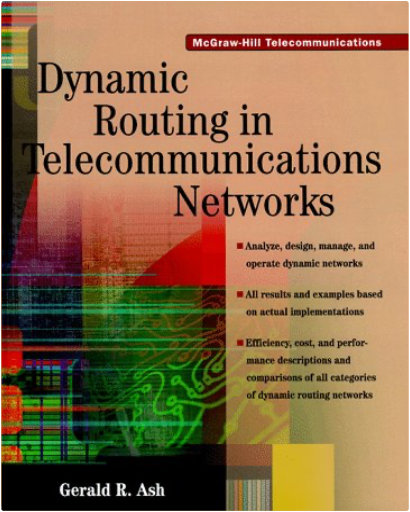 Dynamic Routing in Telecommunications NetworksGerald R. Ash Dynamic Routing in Telecommunications NetworksGerald R. Ash Dynamic routing is vital to the efficient operation and continued growth of every telecommunications network that handles a high volume of calls. Here is the first in-depth treatment of this vital new technology, written by one of its key developers at AT&T. Thorough and practice-focused, it provides network engineers and planners with the tools required to design, operate, and manage dynamic routing networks. Part of the McGraw-Hill Telecommunications Series. 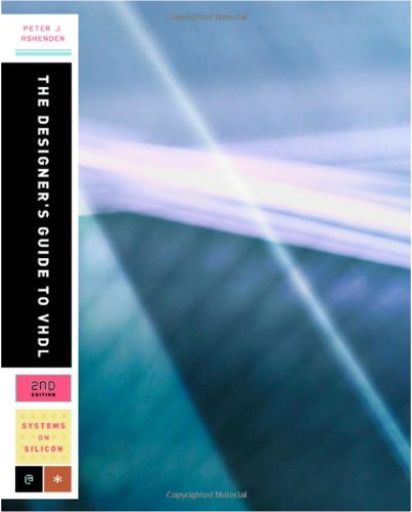 The Designer's Guide to VHDL, Second EditionPeter J. Ashenden The Designer's Guide to VHDL, Second EditionPeter J. Ashenden 4 Since the publication of the first edition of The Designer's Guide to VHDL in 1996, digital electronic systems have increased exponentially in their complexity, product lifetimes have dramatically shrunk, and reliability requirements have shot through the roof. As a result more and more designers have turned to VHDL to help them dramatically improve productivity as well as the quality of their designs.
VHDL, the IEEE standard hardware description language for describing digital electronic systems, allows engineers to describe the structure and specify the function of a digital system as well as simulate and test it before manufacturing. In addition, designers use VHDL to synthesize a more detailed structure of the design, freeing them to concentrate on more strategic design decisions and reduce time to market. Adopted by designers around the world, the VHDL family of standards have recently been revised to address a range of issues, including portability across synthesis tools.
This best-selling comprehensive tutorial for the language and authoritative reference on its use in hardware design at all levels—from system to gates—has been revised to reflect the new IEEE standard, VHDL-2001. Peter Ashenden, a member of the IEEE VHDL standards committee, presents the entire description language and builds a modeling methodology based on successful software engineering techniques. Reviewers on Amazon.com have consistently rated the first edition with five stars. This second edition updates the first, retaining the authors unique ability to teach this complex subject to a broad audience of students and practicing professionals.
* Details how the new standard allows for increased portability across tools.
* Covers related standards, including the Numeric Synthesis Package and the Synthesis Operability Package, demonstrating how they can be used for digital systems design.
* Presents four extensive case studies to demonstrate and combine features of the language taught across multiple chapters.
* Requires only a minimal background in programming, making it an excellent tutorial for anyone in computer architecture, digital systems engineering, or CAD. 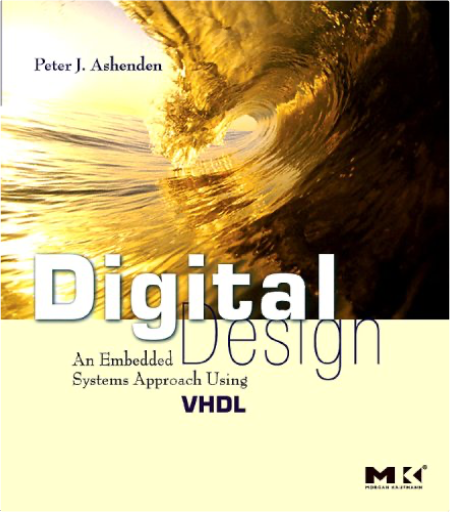 Digital Design (VHDL): An Embedded Systems Approach Using VHDLPeter J. Ashenden Digital Design (VHDL): An Embedded Systems Approach Using VHDLPeter J. Ashenden 4 Digital Design: An Embedded Systems Approach Using VHDL provides a foundation in digital design for students in computer engineering, electrical engineering and computer science courses. It takes an up-to-date and modern approach of presenting digital logic design as an activity in a larger systems design context.
Rather than focus on aspects of digital design that have little relevance in a realistic design context, this book concentrates on modern and evolving knowledge and design skills. Hardware description language (HDL)-based design and verification is emphasized—VHDL examples are used extensively throughout. By treating digital logic as part of embedded systems design, this book provides an understanding of the hardware needed in the analysis and design of systems comprising both hardware and software components.
Includes a Web site with links to vendor tools, labs and tutorials.
Presents digital logic design as an activity in a larger systems design context.
Features extensive use of VHDL examples to demonstrate HDL usage at the abstract behavioural level and register transfer level, as well as for low-level verification and verification environments.
Includes worked examples throughout to enhance the reader's understanding and retention of the material.
Companion Web site includes links to CAD tools for FPGA design from Synplicity, Mentor Graphics, and Xilinx, VHDL source code for all the examples in the book, lecture slides, laboratory projects, and solutions to exercises. 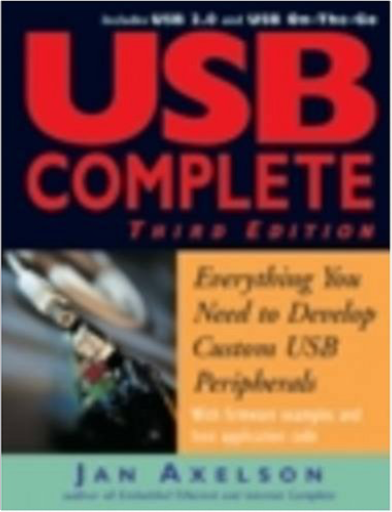 USB Complete: Everything You Need to Develop Custom USB PeripheralsJan Axelson USB Complete: Everything You Need to Develop Custom USB PeripheralsJan Axelson 4 Now in its third edition, this developer's guide to the Universal Serial Bus (USB) interface covers all aspects of project development, including device programming and host application software. This book shows how to transform the information in the USB 3.0 specifications into functioning devices and application software that communicates with the devices. To help build a foundation for design decisions, developers are guided in selecting device-controller hardware. Developers will also learn the benefits of the USB interface, its limitations, and how certain design choices made at the beginning of the project can reduce development time. Recent developments in host and device hardware, more detail on the standard USB classes, application examples using Microsoft's .NET Framework, and information on developing dual-role devices using USB On-The-Go is provided in detail. 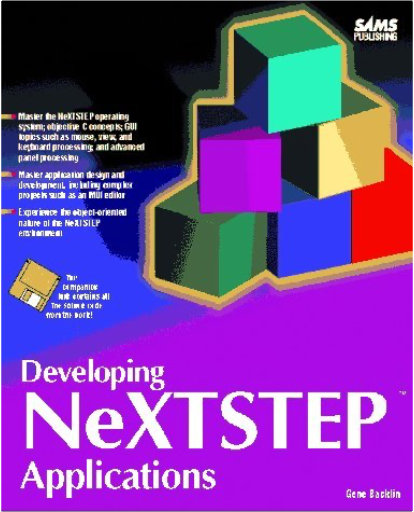 Developing Nextstep Applications/Book and DiskGene Backlin Developing Nextstep Applications/Book and DiskGene Backlin Developing NEXTSTEP Applications will provide beginning NeXT programmers with an approach to the NEXTSTEP environment that will lay a solid foundation. Gene Backlin not only shows how things happen in the NeXT environment, but why they happen as well. It will serve as a tremendous reference book in the future. 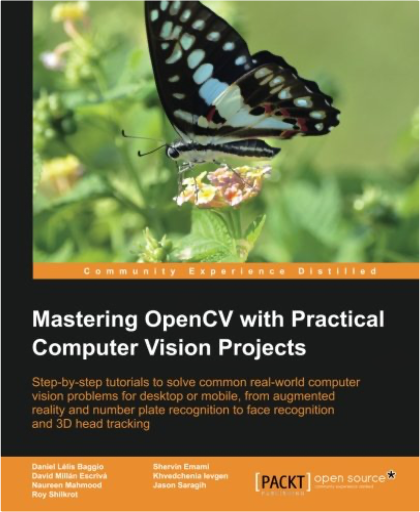 Mastering OpenCV with Practical Computer Vision ProjectsDaniel Lélis Baggio, Shervin Emami, David Millán Escrivá, Khvedchenia Ievgen, Naureen Mahmood, Jasonl Saragih, Roy Shilkrot Mastering OpenCV with Practical Computer Vision ProjectsDaniel Lélis Baggio, Shervin Emami, David Millán Escrivá, Khvedchenia Ievgen, Naureen Mahmood, Jasonl Saragih, Roy Shilkrot This is the definitive advanced tutorial for OpenCV, designed for those with basic C++ skills. The computer vision projects are divided into easily assimilated chapters with an emphasis on practical involvement for an easier learning curve.
OverviewAllows anyone with basic OpenCV experience to rapidly obtain skills in many computer vision topics, for research or commercial useEach chapter is a separate project covering a computer vision problem, written by a professional with proven experience on that topic.All projects include a step-by-step tutorial and full source-code, using the C++ interface of OpenCV.
In Detail
Computer Vision is fast becoming an important technology and is used in Mars robots, national security systems, automated factories, driver-less cars, and medical image analysis to new forms of human-computer interaction. OpenCV is the most common library for computer vision, providing hundreds of complex and fast algorithms. But it has a steep learning curve and limited in-depth tutorials.
Mastering OpenCV with Practical Computer Vision Projects is the perfect book for developers with just basic OpenCV skills who want to try practical computer vision projects, as well as the seasoned OpenCV experts who want to add more Computer Vision topics to their skill set or gain more experience with OpenCV's new C++ interface before migrating from the C API to the C++ API.
Each chapter is a separate project including the necessary background knowledge, so try them all one-by-one or jump straight to the projects you're most interested in.
Create working prototypes from this book including real-time mobile apps, Augmented Reality, 3D shape from video, or track faces & eyes, fluid wall using Kinect, number plate recognition and so on.
Mastering OpenCV with Practical Computer Vision Projects gives you rapid training in nine computer vision areas with useful projects.
What you will learn from this bookPerform Face Analysis including simple Face & Eye & Skin Detection, Fisherfaces Face Recognition, 3D Head Orientation, complex Facial Feature Tracking.Do Number Plate Detection and Optical Character Recognition (OCR) using Artificial Intelligence (AI) methods including SVMs and Neural NetworksLearn Augmented Reality for desktop and iPhone or iPad using simple artificial markers or complex markerless natural imagesGenerate a 3D object model by moving a plain 2D camera, using 3D Structure from Motion (SfM) camera reprojection methodsRedesign desktop real-time computer vision applications to more suitable Android & iOS mobile appsUse simple image filter effects including cartoon, sketch, paint, and alien effectsExecute Human-Computer Interaction with an XBox Kinect sensor using the whole body as a dynamic input
Approach
Each chapter in the book is an individual project and each project is constructed with step-by-step instructions, clearly explained code, and includes the necessary screenshots.
Who this book is written for
You should have basic OpenCV and C/C++ programming experience before reading this book, as it is aimed at Computer Science graduates, researchers, and computer vision experts widening their expertise. |
 Die Grafiken und Aufgaben des Buches MathematikT. Arens, Frank Hettlich, Christian Karpfinger, Ulrich Kockelkorn, Klaus Lichtenegger, Hellmuth Stachel
Die Grafiken und Aufgaben des Buches MathematikT. Arens, Frank Hettlich, Christian Karpfinger, Ulrich Kockelkorn, Klaus Lichtenegger, Hellmuth Stachel  Arbeitsbuch Mathematik: Aufgaben, Hinweise, Lösungen und LösungswegeTilo Arens, Frank Hettlich, Christian Karpfinger, Ulrich Kockelkorn, Klaus Lichtenegger, Hellmuth Stachel
Arbeitsbuch Mathematik: Aufgaben, Hinweise, Lösungen und LösungswegeTilo Arens, Frank Hettlich, Christian Karpfinger, Ulrich Kockelkorn, Klaus Lichtenegger, Hellmuth Stachel 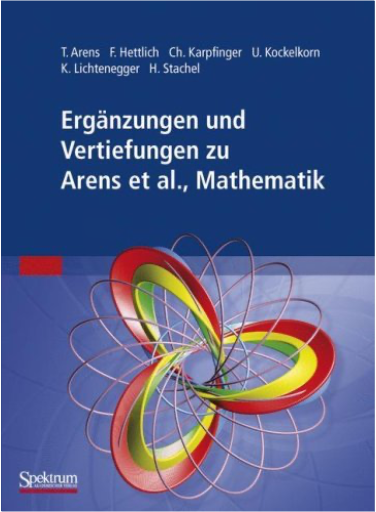 Ergänzungen und Vertiefungen zu MathematikTilo Arens, Frank Hettlich, Christian Karpfinger, Ulrich Kockelkorn, Klaus Lichtenegger, Hellmuth Stachel
Ergänzungen und Vertiefungen zu MathematikTilo Arens, Frank Hettlich, Christian Karpfinger, Ulrich Kockelkorn, Klaus Lichtenegger, Hellmuth Stachel  Dynamic Routing in Telecommunications NetworksGerald R. Ash
Dynamic Routing in Telecommunications NetworksGerald R. Ash  The Designer's Guide to VHDL, Second EditionPeter J. Ashenden
The Designer's Guide to VHDL, Second EditionPeter J. Ashenden  Digital Design (VHDL): An Embedded Systems Approach Using VHDLPeter J. Ashenden
Digital Design (VHDL): An Embedded Systems Approach Using VHDLPeter J. Ashenden  USB Complete: Everything You Need to Develop Custom USB PeripheralsJan Axelson
USB Complete: Everything You Need to Develop Custom USB PeripheralsJan Axelson  Developing Nextstep Applications/Book and DiskGene Backlin
Developing Nextstep Applications/Book and DiskGene Backlin  Mastering OpenCV with Practical Computer Vision ProjectsDaniel Lélis Baggio, Shervin Emami, David Millán Escrivá, Khvedchenia Ievgen, Naureen Mahmood, Jasonl Saragih, Roy Shilkrot
Mastering OpenCV with Practical Computer Vision ProjectsDaniel Lélis Baggio, Shervin Emami, David Millán Escrivá, Khvedchenia Ievgen, Naureen Mahmood, Jasonl Saragih, Roy Shilkrot  Made with Delicious Library
Made with Delicious Library

